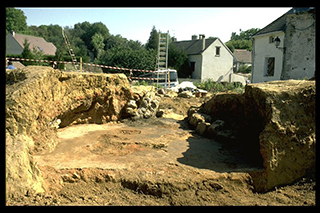Prochain point : lat="49.10437009265267" lon="1.8332047487484537"
ARCHEOLOGY
An ancient settlement
Numerous archeological digs...
The village is replete with evidence of ancient settlement. Many archeological discoveries have been made here, including flint tools, chipped and polished, demonstrating human occupation dating back to the Mesolithic, the phase between the Palaeolithic (finishing around 10,000 BCE) and the Neolithic (6,000 to 2,200 BCE).
Numerous discoveries confirm the site was occupied in Gallo-Roman times: Roman coins found in a vast perimeter around the church; thermal baths with vestiges of hypocausts (an underground heating system used in Roman thermal baths) in what is now the Musée de l’Outil (Tool Museum); fragments of a terra sigillata pouring vase found under the school/town hall during construction (the vase is decorated with reliefs which would have necessitated the use of stamps); the stone well between the church and the Saint-Romain fountain; lime kilns discovered in rue du Puits-de-la-Ville and rue au Coq. As well as tombs from a vast quadrilateral Merovingian necropolis covering around on hectare, uncovered in the north-east of the commune.
...and the discovery of cooking ovens
Prior to the development of Place Jacques Augère in 1996, archeologists discovered three large hemispherical ovens which were used in succession between the end of the 10th century and the middle of the 12th century. Each oven was operational for around fifty years. Their diameters, between 3.40 and 3.90 meters, suggest that they were designed for collective use. The interior was used both for heating and cooking. Fire installations used for cooking can be distinguished from those used by artisans, mainly by the absence of debris and waste (such as slag, pottery fragments etc.). Oak, elm and ash wood were burned first to create a low flame, making the temperature rise slowly and gradually. Then, box tree, vibrunam and hazel wood were added for a high flame, just prior to baking..




